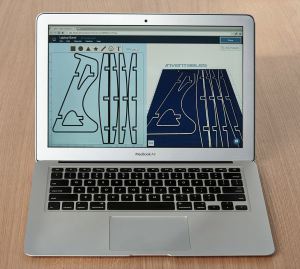Inventables has been working hard on a successor to the extremely popular Shapeoko CNC milling machine, and to bring digital fabrication to the masses, they’ve created Easel, possibly the easiest 3D design software you’ll ever use. [Sacha] was trying out the beta version of Easel and mentioned to the dev mailing list he was running his installation on a Raspberry Pi. One of the developers chimed in, and after a bit of back and forth we now have a workflow to use Easel with the Raspberry Pi.
Easel is a web app, but since the graphics, design, and g-code generation are handled locally, even the most rudimentary CAD suite would choke the decidedly low power Raspi. Instead, [Sacha] is using the Raspberry to grab 2D and 3D files, turn that into g-code for a machine, and send it off to a Shapeoko router.
Easel doesn’t yet have local sender support that works on Linux, so a separate piece of software is used to shoot the g-code over a serial port to the machine. That’s something that will probably be added in a later version of Easel, making a Raspberry Pi a great way to control router or milling machine.
















“…she was running hers…”,
Sacha De’Angeli is a man
Yes, was going to comment this as well! Sacha is definitely not a Her
Any chance I could get a hint on how to pronounce the name, if not “Sasha”? Sa-cha? Sa-ka? Sa-schwa? Like “Steven”?
sacha is pronounced just like sasha.
Sacha Baron Cohen aka Borat is also not a woman.
“Easel is a web app, but since the graphics, design, and g-code generation are handled locally”
Wait, so 1) is this a closed source, cloud app? and 2) if almost everything is handled locally, why make it a web app at all?
Maybe it’s an easy way to handle multiple platforms? If it weren’t a web app, I’m pretty sure they wouldn’t bother to support Linux, much less any ARM Linux.
“Easel does not yet have a local sender that works on Linux”
That’s a relatively minor issue when you can take g code through a native sender.
Agreed. But Linux support doesn’t seem to be native or fully supported (yet?).
It’s an easy way to reach all platforms. It also makes updates easier and transparent to the user. ChiliPeppr took this approach. There are plenty of valid arguments against it, but for me, it beats the pants off of the java based alternatives.
Not a good idea, except as a toy or teaching tool. Cloud based solutions are not worth the compromises to your privacy and security. They are not much use to poor people in areas where the web is absent or unreliable either, the sort of people who would otherwise benefit from a free application with a gentle learning curve.
Cloud based software is evil, don’t use it!
Multiple platforms are not an excuse; using Wine a well written Windows program can run both on Linux and MacOS with no performance issues.
https://appdb.winehq.org/
“even the most rudimentary CAD suite would choke the decidedly low power Raspi”
I disagree, rudimentary CAD programs , i.e. CADKEY originally ran on a 286 platform.
I had that exact thought, I seem to remember learning CD on some pretty poor systems with less resources than the raspberry pi, for both 2D and 3D CAD!
kinda makes you wonder when exactly people forgot how to write software that pay attention to it’s resource footprint!